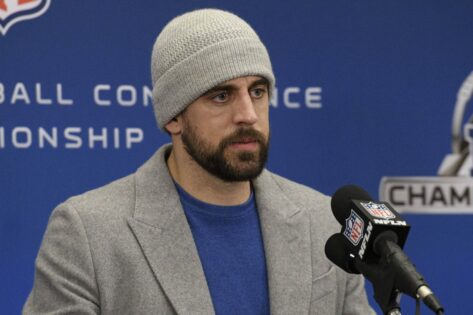They say football is a young man’s game—and they’re mostly right. But that’s never stopped the greats from testing the time. In Super Bowl history alone, 22 quarterbacks have thrown a pass at age 40 or older—names like Tom Brady, Drew Brees, and Brett Favre etched into the biggest stage far past their prime years. It’s inspiring, no doubt. But also sobering. Playing quarterback at 40 is one thing. Succeeding at 40, on football’s grandest stage, is something else entirely.
In over fifty years of playoff football, quarterbacks aged 40 or older have managed just 12 postseason wins, and 10 of them belong to Tom Brady alone. Only Brees and Favre have added a single victory each to that modest tally. So when the Steelers handed Aaron Rodgers a one-year deal this offseason, they weren’t just betting on talent—they were betting against history. A franchise without a playoff win since 2017 is now pinning its hopes on a QB who turns 42 in December.
“I’d love to play to 40,” Rodgers said back in 2018 when he was 35. “I just think that number means a lot. Obviously, Tom (Brady) is kind of rewriting the book. Brett (Favre) had a good season when he turned 40. My goal is to be able to move like I do, or close to how I do, and still be able to do that at 40.” So the question is: Is Aaron Rodgers worthy enough to do what an aged-Brady did in his 40s?
Well, the statistics say Rodgers is no Brady. Because Brady didn’t just play into his 40s—he dominated. From age 40 to 45, the NFL legend led the league with the highest EPA (Expected Points Added), yards, and touchdowns, stacking up playoff wins and even a Lombardi at 43 while recording over 4K yards in every season after turning 40. His EPA per play stayed top-five in the league through age 44 (130 EPA at 44 alone), a statistical outlier in every sense.
Aaron Rodgers, by contrast, is already showing signs of decline before even turning 42, per The Athletic. The Steelers‘ quarterback’s EPA started tapering off after age 38, and his 2023 numbers fell outside the league’s elite. Injuries, scheme shifts, and declining mobility have chipped away at his efficiency. Great as he is, the number suggests he’s not on Brady’s aging curve—and history rarely makes exceptions.
Newly-signed quarterback for the Pittsburgh Steelers Aaron Rodgers 8 works out at the Steelers mini-camp on Tuesday, June 10, 2025 in Pittsburgh. PUBLICATIONxINxGERxSUIxAUTxHUNxONLY PIT2025061020 ARCHIExCARPENTER
Think about this—since 2000, the gap between Tom Brady and every other quarterback over 40 isn’t just noticeable, it’s defining. In regular seasons, Brady showed up 98 times, started every game, and had a 68-30 record. Other QBs? 157 games, 108 starts, and a 52-56 record. After turning 40, Brady piled up 27,632 yards, while other QBs managed to rack up just 24,941 yards—again, that’s 98 starts vs. 108 starts.
Meanwhile, Rodgers ruptured his Achilles three months before his 40th birthday in his Jets debut, abruptly ending his first season in New York. From there, everything went south. The 41-year-old quarterback (after a torn Achilles and reported knee and hamstring issues), compromised mobility in 2024 and recorded a negative EPA per dropback against the blitz (-0.19), according to TruMedia. The worst among the QBs who attempted at least 300 passes.
Add 40 sacks to it, and it’s safe to say that, ahead of the 2025 season, which is reportedly his last in the NFL, Aaron Rodgers is declining. In the case of Brady, injuries were never a part of his elite game. He started all 112 possible games, including playoffs, in his final six games. That said, the Steelers are now counting on Rodgers, but the skepticism is higher than optimism with his Steelers stint.
Aaron Rodgers can follow Brett Favre to succeed in his 40s
The first quarterback to lead a legitimate playoff contender after turning 40 was none other than Aaron Rodgers’ predecessor in Green Bay, Brett Favre. After an offseason full of speculations, Favre returned to join the loaded Minnesota Vikings, despite having an arthroscopic surgery on his right (throwing) shoulder in June 2009, stemming from a torn biceps tendon suffered the previous season.
Favre piled up his sixth 4,000+ yard season, with 33 touchdowns and just 7 interceptions, and led the Vikings to the playoffs after a stellar 12-4 regular season record, earning his 11th Pro Bowl nod. Then came the playoff month. Favre threw four touchdown passes in the divisional round win and led Minnesota to the NFC Championship round, a postseason run unique for a 40-year-old at that time.
Though the Vikings ultimately lost in overtime in the Conference Championship round, Favre still racked up 316 yards, one touchdown, and just two picks. He went on to play another season at 41, but that spark was gone. Meanwhile, Aaron Rodgers is now entering his 21st season in the NFL, and he’s already revealed that it will be his last season.
The four-time MVP hasn’t tasted postseason victory since 2020, and the Steelers haven’t broken their playoff drought since 2017. The Steelers want to end their playoff drought, and Rodgers wants to end his career on a high note. Could this be the year? That remains to be seen.
The post Aaron Rodgers Has Already Lost Before Starting for Steelers as Tom Brady’s Legacy Gives Harsh Reality Check appeared first on EssentiallySports.
